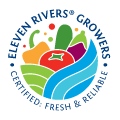Integrated Pest Management (IPM)
2.8.1. Strategic plan
The company must document and implement a Strategic Plan for the Integrated Pest Management including Control strategies and methods that are effective against the pests detected. Similarly, to reduce environmental impact, through the use of parasitoids, predators, pheromones, repellents, pest resistant and/or tolerant varieties, etc.
2.8.2. Pest monitoring program
The company must develop, document and implement a Pest Monitoring Program. The responsible technician may be supported by professional subcontracted services, social service providers from Universities and/or Research Centers that have been previously trained in the IPM.
The Monitoring Program will establish the species of pests subject to research, monitoring methods and frequencies.
2.8.3. Cost-benefit analysis
Based on pest analyses, cost-benefit analyses must be developed between the cost it would represent to control pests in a traditional manner (according to its economic threshold of pests and diseases) and the cost it would represent its control through the IPM.
2.8.4. Analysis of pests and their environment
Every species must be studied and handled from a population viewpoint, considering the ecosystem in which it is developing. The responsible technician must develop the documental support of the technical information of existing pests in the agriculture production modules.
The assessment must consider aspects such as crop resistance and/or tolerance, host plants, behavior and pest density, direct damage caused to crops, weather conditions and the presence of natural enemies.
2.8.5. Control methods based on cultural practices
For this method implementation, it is essential to know the crop development, what are the most susceptible stages for pest infestation.
The grower must respect planting dates established by the authorities (in the cases where a local or regional regulation exists on the official season beginning and/or plant health windows) and to conveniently destroy crop residues after finishing the harvest stage.
2.8.6. Control methods based on crop tolerance or resistance
As part of the IPM, the company must update varieties or hybrids with pests and diseases tolerance and/or resistance: this may help to prevent the application of agrochemical, favors the beneficial fauna and the environment.
2.8.7. Methods based on biological control
Biological control must describe the actions to implement to look after and reinforce the action of biological control agents. Within these actions it may release or apply species in the field, such as parasitoids, predators, and enthomopathogen microorganisms (fungi, bacteria and viruses) that are produced in Centers or Labs specialized.
A Monitoring Program of the presence of natural pest enemies must be developed. In the agriculture production modules it will be frequent to find in a natural manner, species such as ladybirds, lacewings, eye bugs, pirate bugs, parasitoid wasps, etc.
2.8.8. Interference methods
The IPM must contemplate the application of pheromones and insect repellents. Technical specifications of data sheets and safety data sheets of the products used must be documented; as well as to verify they are compliant with specifications both in the country of origin and the country of destination of the marketed agriculture products.



